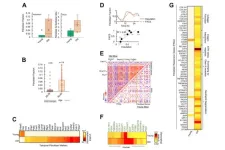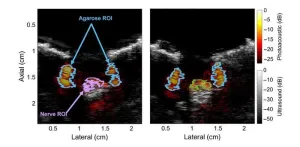(Press-News.org) Reston, VA—The Society of Nuclear Medicine and Molecular Imaging (SNMMI) has issued a new consensus statement to provide standardized guidance for the selection and management of metastatic castrate-resistant prostate cancer (mCRPC) patients being treated with 177Lu-PSMA radionuclide therapy. The statement, published in the July issue of The Journal of Nuclear Medicine, also reviews current clinical struggles physicians face during treatment with 177Lu-PSMA-617 radionuclide therapy.
Recently, the U.S. Food and Drug Administration approved 177Lu-PSMA-617 for the treatment of men with mCRPC after progressing on taxane-based chemotherapy and at least one line of androgen receptor pathway inhibitors (ARPI). To develop the patient selection criteria and determine appropriate use scenarios, SNMMI assembled an autonomous workgroup to represent a multidisciplinary panel of health care providers with substantive knowledge in the use of nuclear medicine in 177Lu-PSMA-617 radionuclide therapy. The workgroup conducted a review of the four prospective phase 2 and phase 3 trials that used 177Lu-PSMA-617 registered on clinicaltrials.gov to develop consensus recommendations.
In terms of patient selection, workgroup members agreed that PSMA PET should be performed within three months of treatment or since progression on the last therapy to ensure that the current disease state is represented. If disease progression or intervening therapy is evident, PSMA PET should be repeated. Either 18F-DCFPyL or 68Ga-PSMA-11 can be used for PSMA PET imaging, and 18F-FDG PET is not required as a standard patient selection tool. In addition, patients should be imaged with either contrast-enhanced CT or MRI to identify potential PSMA-negative disease. Baseline requirements for renal and bone marrow functions were also noted.
Treatment of mCRPC after chemotherapy and ARPI was considered appropriate, while treatment of mCRPC after ARPI and before chemotherapy was considered rarely appropriate. The working group also agreed that treatment of patients with metastatic castration-sensitive prostate cancer was rarely appropriate.
Furthermore, the consensus statement addressed current clinical struggles that physicians face when administering 177Lu-PSMA-617 radionuclide therapy. These include the role of androgen receptor-targeted therapies, the role of 223Ra, treatment-related toxicities, when to consider cessation of treatment, exceptional responders and restarting treatment, and imaging during treatment.
“With the approval of 177Lu-PSMA-617, a new class of therapeutics is available to patients with prostate cancer. We look forward to the potential use of PSMA radionuclide therapy in pre-chemotherapy mCRPC or other settings pending the full results of ongoing trials,” noted the authors.
The full consensus statement on patient selection and appropriate use of 177Lu-PSMA-617 radionuclide therapy can be viewed on SNMMI’s website.
This article was made available online in June 2023.
The authors of “SNMMI Consensus Statement on Patient Selection and Appropriate Use of 177Lu-PSMA-617 Radionuclide Therapy” include Thomas A. Hope, Department of Radiology and Biomedical Imaging, University of California San Francisco, San Francisco, California; Emmanuel S. Antonarakis, 2 University of Minnesota Masonic Cancer Center, Minneapolis, Minnesota; Lisa Bodei, Molecular Imaging and Therapy Service, Department of Radiology, Memorial Sloan Kettering Cancer Center, New York, New York; Jeremie Calais, Ahmanson Translational Theranostics Division, Department of Molecular and Medical Pharmacology, David Geffen School of Medicine, UCLA, Los Angeles, California; Amir Iravani, Department of Radiology, University of Washington, Seattle, Washington; Heather Jacene, Department of Radiology, Brigham and Women’s Hospital, and Department of Imaging, Dana-Farber Cancer Institute, Boston, Massachusetts; Phillip J. Koo, Banner M.D. Anderson Cancer Center, Phoenix, Arizona; Alicia K. Morgans and Mary-Ellen Taplin, Lank Center for Genitourinary Oncology, Dana-Farber Cancer Institute, Boston, Massachusetts; Joseph R. Osborne, Molecular Imaging and Therapeutics, Department of Radiology, Weill Cornell Medicine, New York, New York; Scott T. Tagawa, Department of Medicine, Weill Cornell Medical College, New York, New York; Oliver Sartor, Mayo Clinic, Rochester, Minnesota; and Michael J. Morris, Genitourinary Oncology Service, Memorial Sloan Kettering Cancer Center, New York, New York.
Visit the JNM website for the latest research, and follow our new Twitter and Facebook pages @JournalofNucMed or follow us on LinkedIn.
###
Please visit the SNMMI Media Center for more information about molecular imaging and precision imaging. To schedule an interview with the researchers, please contact Rebecca Maxey at (703) 652-6772 or rmaxey@snmmi.org.
About JNM and the Society of Nuclear Medicine and Molecular Imaging
The Journal of Nuclear Medicine (JNM) is the world’s leading nuclear medicine, molecular imaging and theranostics journal, accessed 15 million times each year by practitioners around the globe, providing them with the information they need to advance this rapidly expanding field. Current and past issues of The Journal of Nuclear Medicine can be found online at http://jnm.snmjournals.org.
JNM is published by the Society of Nuclear Medicine and Molecular Imaging (SNMMI), an international scientific and medical organization dedicated to advancing nuclear medicine and molecular imaging—precision medicine that allows diagnosis and treatment to be tailored to individual patients in order to achieve the best possible outcomes. For more information, visit www.snmmi.org.
END
JNM publishes consensus statement on patient selection and appropriate use of Lu-177 PSMA-617 radionuclide therapy
2023-09-05
ELSE PRESS RELEASES FROM THIS DATE:
Making plant-based meat more ‘meaty’ — with fermented onions
2023-09-05
Plant-based alternatives such as tempeh and bean burgers provide protein-rich options for those who want to reduce their meat consumption. However, replicating meat's flavors and aromas has proven challenging, with companies often relying on synthetic additives. A recent study in ACS’ Journal of Agricultural and Food Chemistry unveils a potential solution: onions, chives and leeks that produce natural chemicals akin to the savory scents of meat when fermented with common fungi.
When food producers want to make plant-based meat alternatives taste ...
Water-quality risks linked more to social factors than money
2023-09-05
When we determine which communities are more likely to get their water from contaminated supplies, median household income is not the best measure.
That’s according to a recent study led by researchers at The University of Texas at Austin that found social factors — such as low population density, high housing vacancy, disability and race — can have a stronger influence than median household income on whether a community’s municipal water supply is more likely to have health-based water-quality violations. In general, rural communities and communities that grew up around large industries that have since left are most likely to face water-quality issues.
About 10% ...
Researchers use AI to find new magnetic materials without critical elements
2023-09-05
A team of scientists from Ames National Laboratory developed a new machine learning model for discovering critical-element-free permanent magnet materials. The model predicts the Curie temperature of new material combinations. It is an important first step in using artificial intelligence to predict new permanent magnet materials. This model adds to the team’s recently developed capability for discovering thermodynamically stable rare earth materials.
High performance magnets are essential for technologies such as wind energy, data storage, electric vehicles, ...
Aging alters pancreatic circadian rhythm
2023-09-05
“Overall, our study identified previously unknown circadian transcriptome reorganization of pancreas by aging [...]”
BUFFALO, NY- September 5, 2023 – A new research paper was published in Aging (listed by MEDLINE/PubMed as "Aging (Albany NY)" and "Aging-US" by Web of Science) Volume 15, Issue 16, entitled, “Reorganization of pancreas circadian transcriptome with aging.”
The evolutionarily conserved circadian system allows organisms to synchronize internal processes with 24-h cycling environmental timing cues, ensuring optimal adaptation. Like other organs, the pancreas function is under circadian control. Recent evidence ...
Visualizing nerves with photoacoustic imaging
2023-09-05
Invasive medical procedures, such as surgery requiring local anesthesia, often involve the risk of nerve injury. During operation, surgeons may accidentally cut, stretch, or compress nerves, especially when mistaking them for some other tissue. This can lead to long-lasting symptoms in the patient, including sensory and motor problems. Similarly, patients receiving nerve blockades or other types of anesthesia can suffer from nerve damage if the needle is not placed at the correct distance from the targeted peripheral nerve.
Consequently, researchers have been trying to develop medical imaging techniques to mitigate the risk of nerve damage. For instance, ultrasound and magnetic resonance ...
Study of “revolving door” in Washington shows one-third of HHS appointees leave for industry jobs
2023-09-05
LOS ANGELES – Almost one-third of government appointees to the Department of Health and Human Services (HHS) leave to take jobs in private industry, according to a study by the USC Schaeffer Center for Health Policy & Economics and Harvard University.
The study, published in Health Affairs, is the first to quantify the personnel movement between health-care industries and the government agencies that regulate them, according to the authors. Although there are understandable reasons for people to move between the public and private sectors, the study notes that such a revolving door could make government agencies more vulnerable to pro-industry bias.
“Laws passed ...
DOACs reduce dementia risk in Asian AFib patients compared to traditional blood thinners
2023-09-05
The use of direct oral anticoagulants (DOACs) was associated with a reduction in dementia risk compared to traditional blood thinners—like warfarin—in atrial fibrillation patients, particularly in Asian patients. According to a study published today in JACC: Asia, this benefit may reverse with increased age and necessitates further follow-up study.
“Asian patients are more likely to be sensitive to vitamin K antagonism, which puts them at high risk for bleeding events, contributing to dementia development ...
New research sheds light on origins of social behaviors
2023-09-05
ITHACA, N.Y. – Male fruit flies don’t usually like each other. Socially, they reject their fellow males and zero in on the females they discern via chemical receptors – or so scientists thought.
New research from Cornell University biologists suggests the fruit fly’s visual system, not just chemical receptors, are deeply involved with their social behaviors. The work sheds light on the possible origin of differences in human social behaviors, such as those seen in people with bipolar disorder ...
New Chagas research unravels decades-long mystery of how the tropical disease progresses
2023-09-05
New research from Tulane University may shed light on how parasite strain diversity can impact Chagas disease progression and severity.
Chagas, a lesser-known and studied tropical disease, is caused by Trypanosoma cruzi parasites, which are transmitted by kissing bugs. In the Americas, the disease affects 6 million people in 21 countries, with approximately 30,000 new cases each year. While most infected patients remain asymptomatic, about 20-40 percent of those infected will develop chronic heart disease ...
Electrifying heavy-duty vehicles could reduce environmental inequalities
2023-09-05
New simulations model traffic-related air pollution over the region surrounding Chicago, North America’s largest freight hub
In the simulations, the researchers modeled a scenario in which 30% of current on-road heavy-duty vehicles (HDVs) were replaced by electric HDVs
Electrifying HDVs would substantially reduce air pollution and save hundreds of lives annually in the region, with particularly large health benefits in predominantly Black, Hispanic and Latinx communities
The region also would save nearly $6 billion annually in avoided ...



